I was intending to write about Ampton Street a couple of weeks ago, It is the location of one of my father’s photos, taken in 1947, of a street with a cleared bomb site along one side of the street.
This was one of the photos my father had printed, and on the reverse was written Ampton Street, Gray’s Inn Road. I had assumed the photo was taken from Gray’s Inn Road (I will explain why later), but when I got home and checked the photos side by side on the computer, it was obvious that I had taken the photo at the wrong end of the street. I had a day off from work last week, so on a rather lengthy walk, I included Ampton Street on the route and finally photographed the scene from the correct end of the street.
Ampton Street is shown in the following map extract. In the very centre of the map, a relatively short street running right from Gray’s Inn Road towards Cubitt Street. (Map “© OpenStreetMap contributors”).
This is my father’s photo taken in 1947. The view is looking from Cubitt Street, along Ampton Street, in the direction of Gray’s Inn Road. A length of Ampton Street has been cleared of houses following considerable bomb damage.
The first house still standing on the right hand side of the street is on the junction with Ampton Place, so the entire terrace of houses from Ampton Place to Cubitt Street has been destroyed.
This area on both sides of Gray’s Inn Road suffered considerable bomb damage during the war.
The LCC Bomb Damage Maps showing the houses on the cleared space as “total destruction”. The houses on the left of the street are colour coded purple “damaged beyond repair” and red “seriously damaged”. This also applied to many of the buildings in the street directly opposite Ampton Street on Gray’s Inn Road and there are new buildings now covering these areas.
A V1 flying bomb also landed just south of Ampton Street on the area just behind what is now the Eastman Dental Hospital (the old Royal Free Hospital).
I love the detail in these photos, in this one there are a couple of children playing in the street:
This is the same view today:
I took the photo a bit to the left of where my father was standing in order to get a slight view up Amton Street.
The bomb site is now covered by the brick buildings on the right of the photo and the open space on the left is also covered by new buildings.
Ampton Street is now closed off to through traffic with only a pedestrian walkway and cycle lane running through into Cubitt Street. Looking through the gap between trees and buildings it is just possible to see the porticos on the houses on the left, far more clearly shown in my father’s photo as in 1947 there was a clear view along the street.
These are the buildings on the cleared bomb site:
In my father’s photo, a couple of the buildings have a portico over the entrance. These are still visible today and a couple of buildings have also had porticos added since 1947.
The LMA Collage archive includes a 1972 photo of the same terrace of houses as shown in my photo above. A number of the houses look to be in a rather derelict state, with broken windows and boarded up ground floor windows. Rather amazing considering the prices these houses would sell for today.
Image credit: London Metropolitan Archives, City of London: catalogue ref: SC_PHL_01_333_72_716
This is the view leading into Ampton Place. The house on the left is the one seen at the end of the cleared bomb site in the 1947 photo.
This is the view looking down Ampton Street towards Cubitt Street. The housing on the left occupies the 1947 bomb site:
This is the photo I took a couple of weeks ago, looking across Gray’s Inn Road towards Ampton Street, thinking at the time it was the right place.
In my defence it was a hot day, I had already walked for miles, and I was looking at the original photo as a small printout. I had assumed that the park area on the right of Ampton Street was the old bomb site, however it should have been very obvious that the houses on the left are different to the original photo and the house just visible on the right is too close to Gray’s Inn Road to be the house in the original photo.
Ampton Street was built between 1821 and 1827 by Thomas Cubitt. The land between Gray’s Inn Road and the Fleet River was owned by Lord Calthorpe and in 1814 he applied for an Act of Parliament to approve the paving of streets on his land.
Some of this land was leased to Thomas Cubitt who built Ampton Street, Frederick Street, and the street now named after the builder, Cubitt Street (however at the time it was called Arthur Street.)
The houses that remain in Ampton Street are perfect examples of Cubitt’s early 19th century designs. This is the terrace running from the Gray’s Inn Road to Ampton Place along the northern side of Ampton Street. On the far right of the photo can be seen the new builds on the old bomb site. This original terrace probably shows what the destroyed terrace looked like.
A rather nice street name plaque:
It is unusual to walk these early 19th century streets and not find a street without a plaque recording a previous resident and Ampton Street continues this rule with an LCC plaque recording that Thomas Carlyle, the Scottish writer, historian, and key founder of the London Library lived here from 1831 to 1834. It was his first London residence after moving from Craigenputtock, a very rural location in south west Scotland where Carlyle lived with his wife.
Carlyle wrote about his stay in Ampton Street that they spent “an interesting, cheery, and in spite of poor arrangements, really pleasant winter. We lodged in Ampton Street, Gray’s Inn Lane, clean and decent pair of rooms, and quiet decent people. Visitors in plenty, John Mill one of the most frequent, Jeffrey, Lord Advocate, often came on an afternoon.”
Thomas Carlyle’s house in the centre of the photo:
The area around Ampton Street, covering Lord Calthorpe’s original land still has many of the original early 19th century buildings and shows the development of the city as formal streets and housing spread north. There is a Calthorpe Street, named after the original owner of the estate, running from Gray’s Inn Road to King’s Cross Road to the south of Ampton Street.
It was a pleasure to make a return visit, however also a lesson that I need to more carefully check the original scene.
When my father’s photos include children, I always wonder if they are still alive. The two playing in the middle of the street in 1947 would I suspect now be in their late 70s – and if they came back to Ampton Street, I suspect they would be very surprised by how good the street looks today.

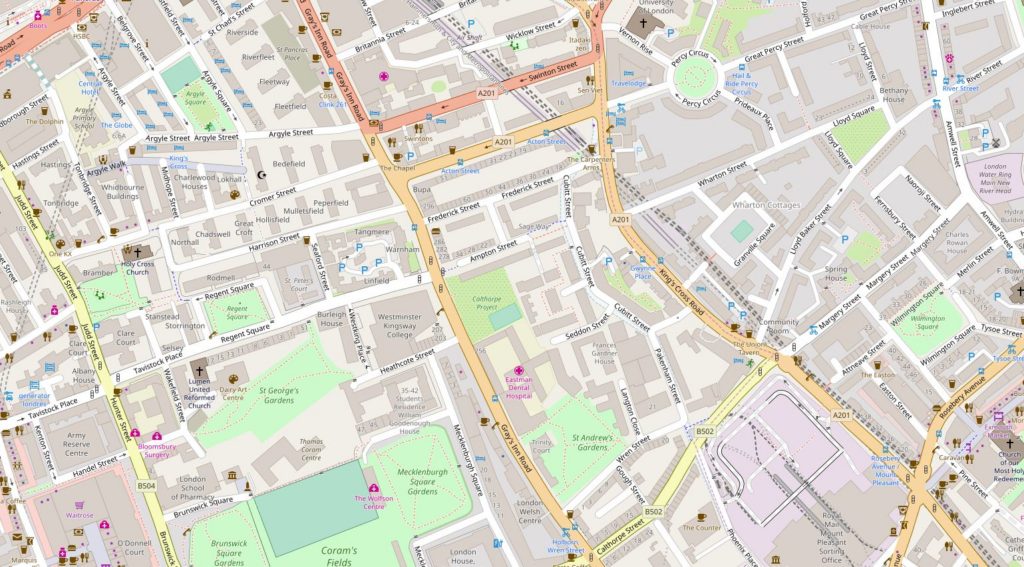
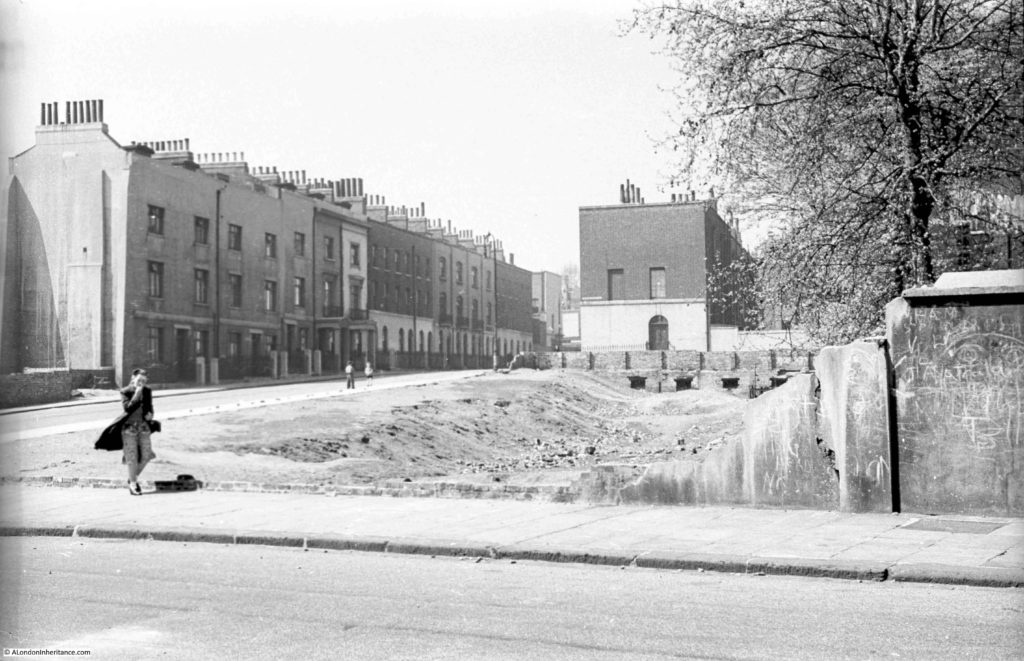
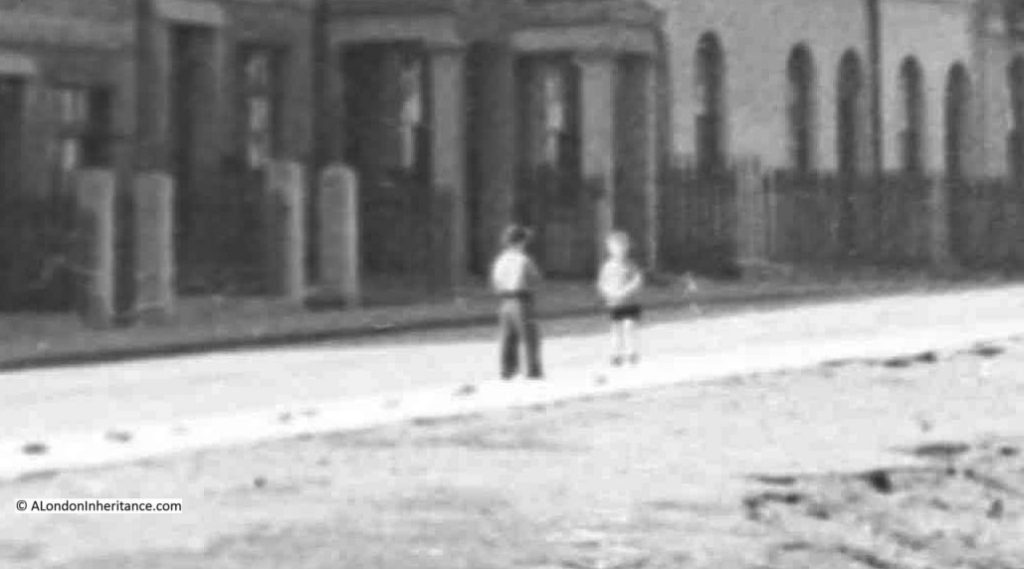
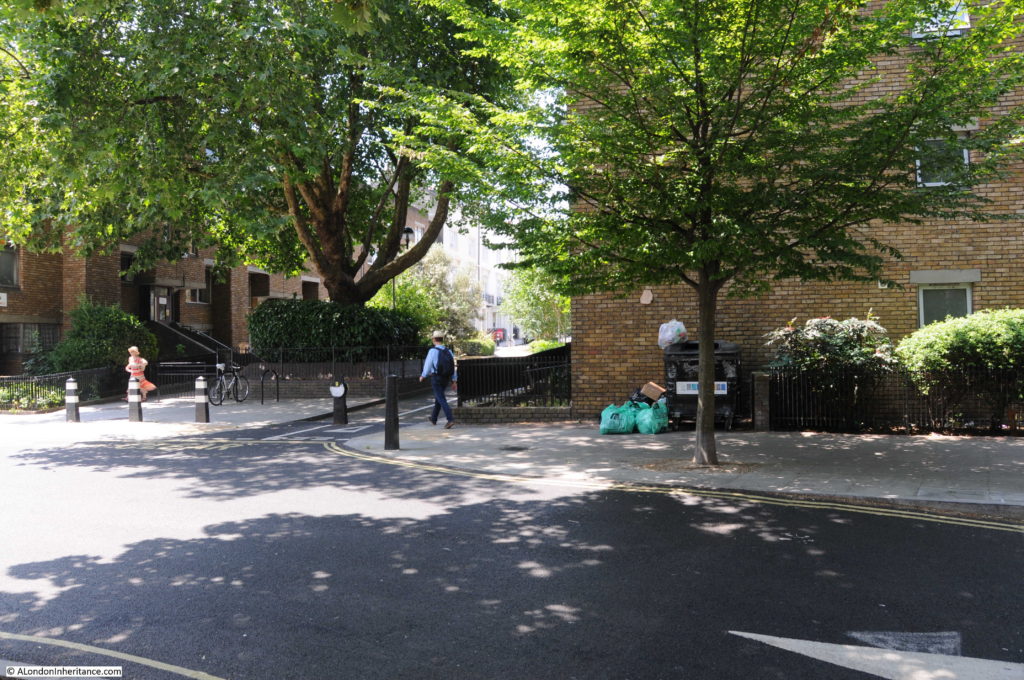

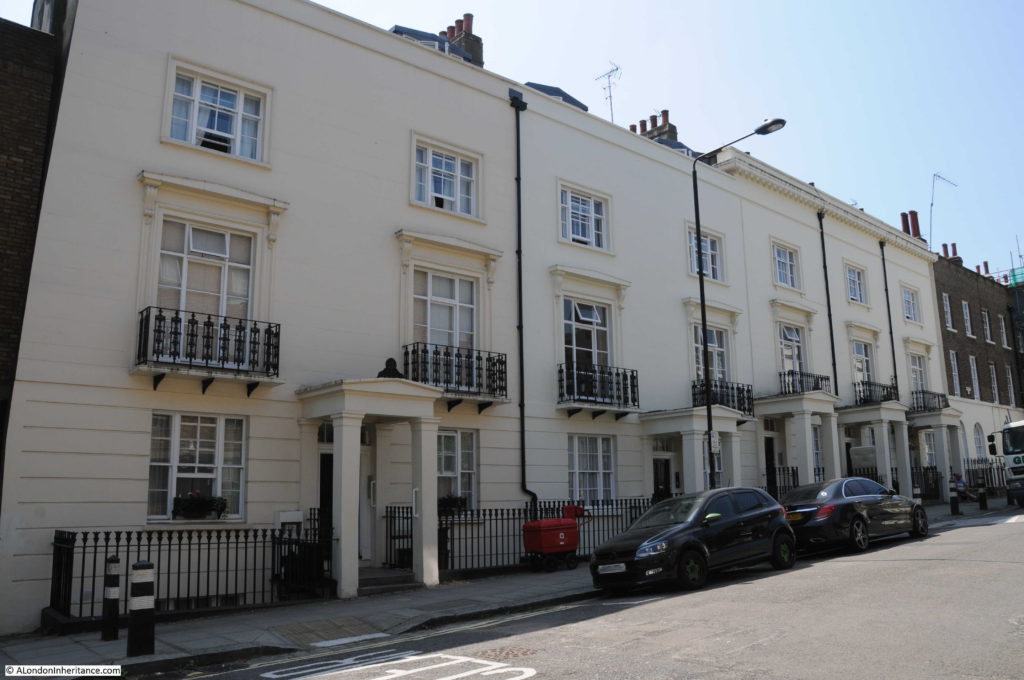

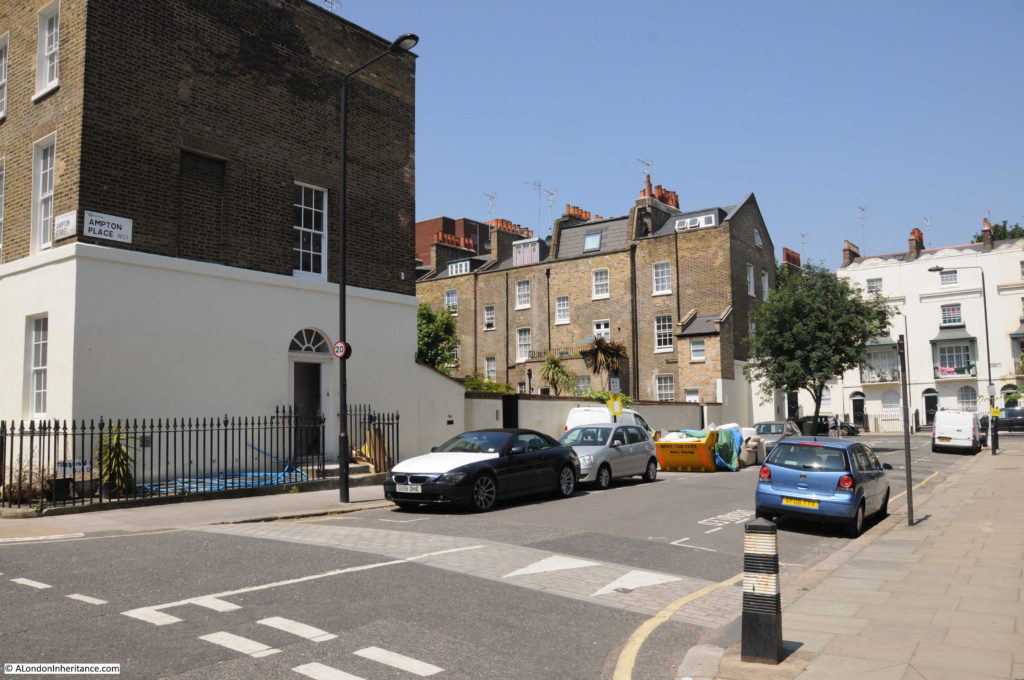

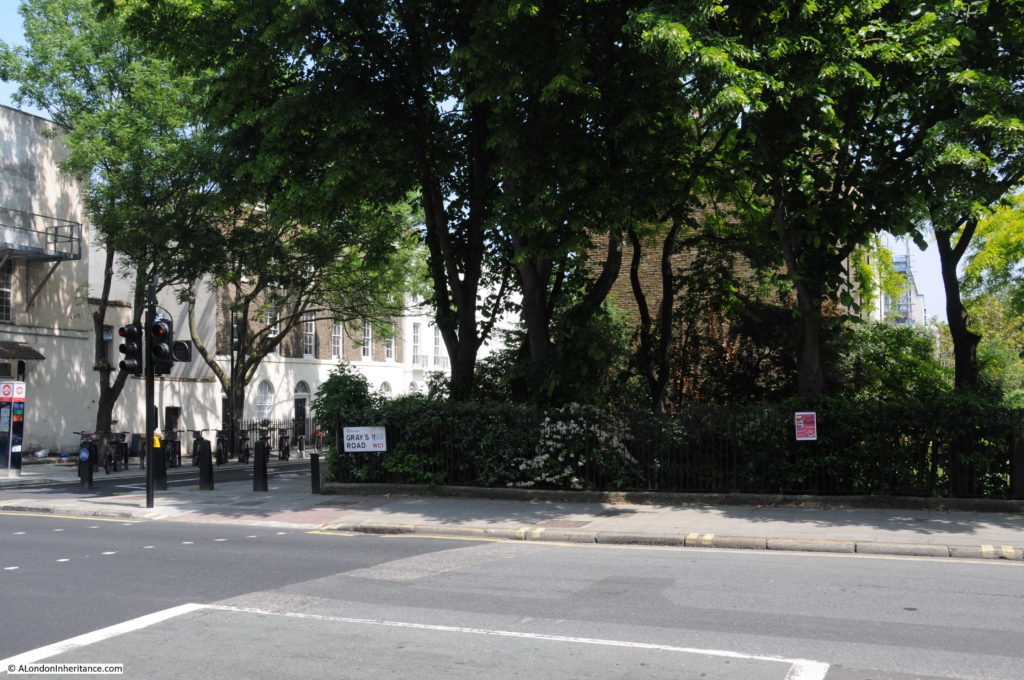
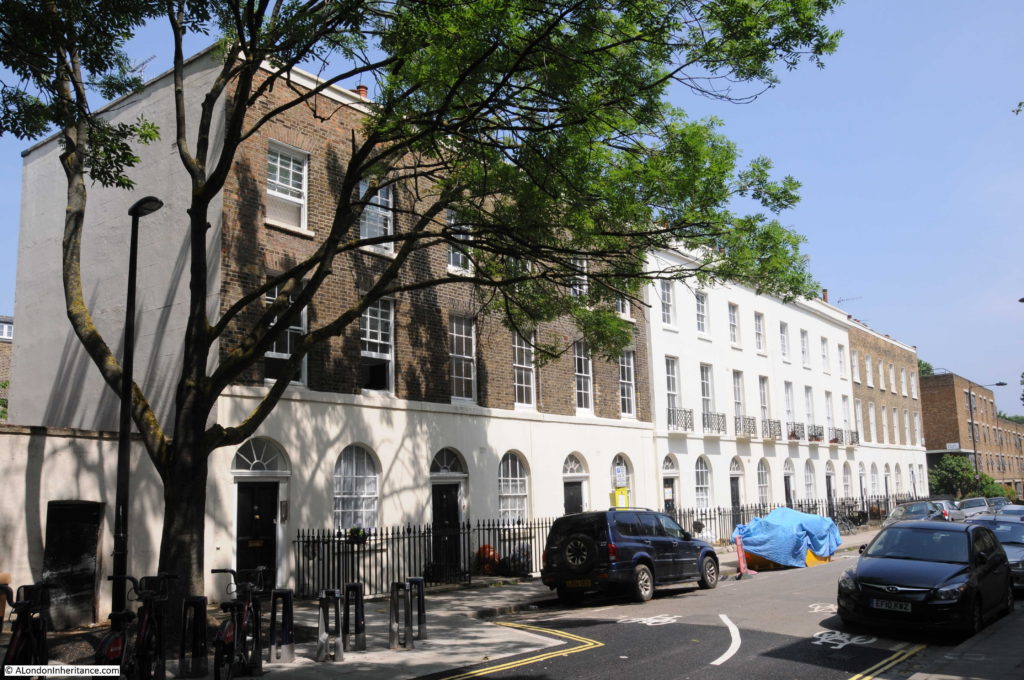
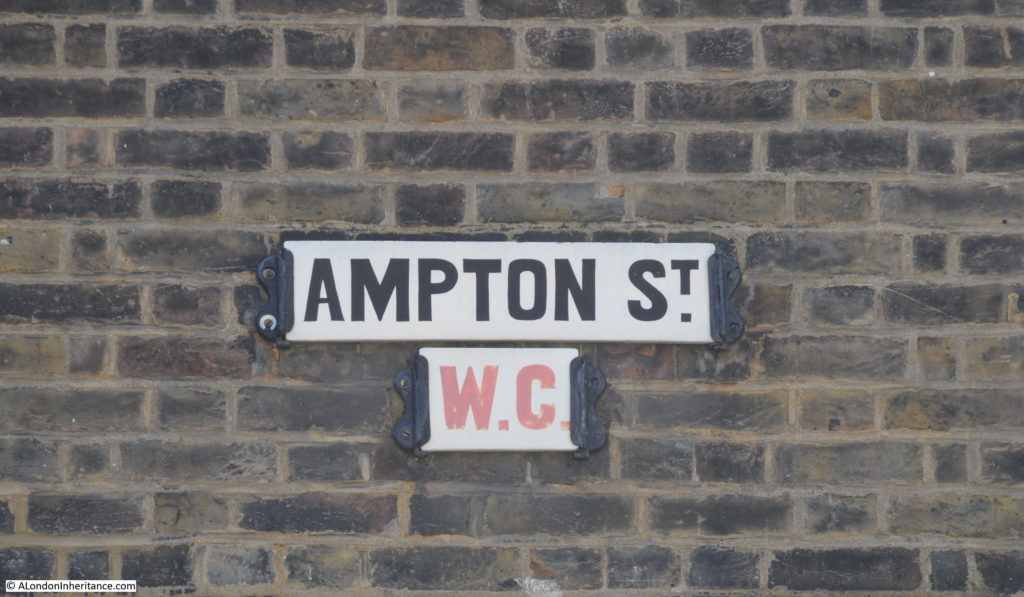
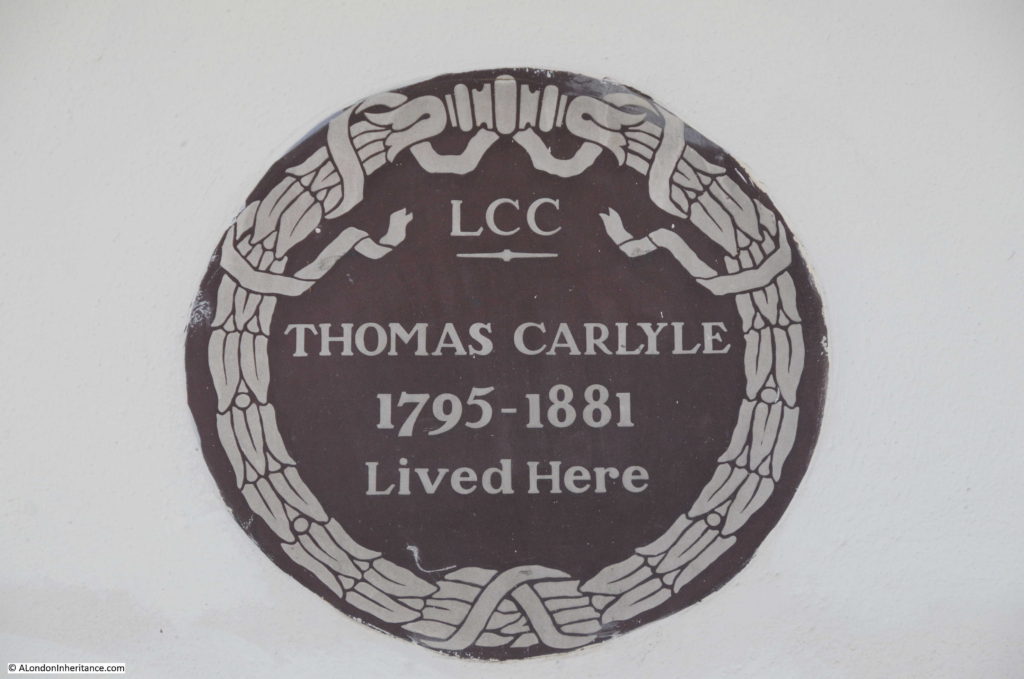

As always, a fascinating read. Thank you for taking the time and trouble to research and write such interesting articles.
Another post full of interest,Admin. I admire the way you returned to retake the photo,especially with the extremely hot weather we’ve had. Not very pleasant to be trudging through the London streets in these temperatures. I hope you found a suitable wet reward somewhere?
In the early 1970s practically all the properties in Ampton St, Ampton Place, Frederick St, Calthorpe St were bought by a housing association and I think most are still in their ownership.
I and others were squating in soe of the house around there in order to stop the council demloshing them! Hardly seems possible they would do such a thing. So I am very happy they became housing assoc places and that their beuty is saved
I love this part of London and often walk through it when travelling from Kings Cross to London Bridge – if the bag isn’t too heavy and the weather is clement, it is a good 45 minute stride after two plus hours sitting on a train. And yes, there is always something very interesting around a corner. I am very interested in the lay of the land too because of all the subterranean waterways making their ways down to the Thames. Amazing that so much of the building survived the last war.
My Great Aunts used to live at Thomas Carlyle’s house, 33 Ampton St in the 1930s, on the top floor. Rented, as they were not well off. My Mum used to visit them.
Thank you
When I was a pupil (trainee barrister) I lived in one of the houses you have pictured
The landlady (Mrs Chance) let the rooms to students and members of Gray’s Inn.
We were only allowed to bring women into the house under her strict supervision!
And that was in the Sixties!
Best
David
I hope you visit the area of Cartwright Gardens that I think is in the vicinity of your last blog. We stay there when ever we visit London. The hotel is on a crescent
Surprising dress of the woman in the 1947 picture. I thought leggings were a recent fashion, clearly not.
Thank you for the photo, it bought back memories for me, I used to live 276a Grays Inn Road, which is the top right house in Ampton St, over what used to be a fruit and veg shop, from 1946 until about 1963, all of my friends lived in the houses in your photo x
Brings back memories. We lived at 19 frederick st and I played with all the other kids in ampton st and ampton place, it was like a little separate community. In 1961 I knew a girl called Molly who lived in ampton st and with whom I fell very much in love but we were just kids and it never progressed. Ah well, such is life’s rich pattern !
Were you very tall for your age with red hair?
I remember you when we were young, yes I did have red hair. Molly was my friend, she lived in the end house, Number 11. Other friends you might remember Teresa next door to Molly Number 13 or Perry Number 20 x
I sure do remember yourself, Molly, Teresa and Perry. We were all about 14 years old and starting to think about other things rather than football or netball ! In those days my best friend was Barry Saunders whose family had recently moved from Ampton st to the newly built flats on the other side of Grays Inn rd. On one occasion I think I remember talking to you about a forthcoming merger of our two secondary schools to form a large comprehensive called Acland Burghley. Am I right or is my memory playing tricks?
I think you lived near or was friends with Ronnie Cochran x
I lived 2 doors along from Ronnie Cochran ( number 23), who was one of my best friends during our primary school days. Very often after school , having finished my tea I used to run downstairs, out onto the ‘debris ‘ then into his house to catch children’s hour on his TV.
I lived just a 2-minute walk from Ampton Street in Packingham Street. This was in the early 70s. I was 12 in 1970 and would spend most days playing for hours in the adventure playground at the old bomb site at the end of Ampton Street. I have many great memories of my time back then, which I treasure greatly.
My grand mother was born in 1867 in 1 Ampton Place, and we have just found a very touching letter written by her father just an hour after she was born! “My dearest Grandmamma, whatever will you think at having a letter from your first grand child? Oh, but I have such delightful news to tell you. But I daresay, you have guessed already ! Yes, I have just been born! Don’t I like this world, and dear Mamma and dear Papa, and Nursey, and good Mrs Bower too.”……………. 1/4 to 1am, 28th September 1867. (all in beautiful hand writing – and we are going to look at this site on 17th Feb. 2019)
Wow, this is amazing!
I live in the house in the photograph, on the corner of Ampton Street and Ampton Place.
It’s quite emotional to see the house and the street like this, especially as older generations of the family would’ve been living here at the time.
I’m keen to get in touch with you, please let me know if this would be possible.
Thank you
my friend Peri lived 20 Ampton Street, later moved round the corner to 18 Ampton Place, it must be the house you live in .
Would that be Peri Marouksy (sorry for the misspelling) On summer evenings we all used to sit on her doorstep listening to radio Luxembourg.
Yes the very same . We was listening to music on her doorstep x
Your sister was a friend of my sister, Jean (Jones). I remember you, you had red curly hair. I also remember Maureen and Michael Harrington on our side of the street and Jack Sage across the road. His parents had a television in 1952. We often watched it through his window.
I remember the Harringtons, they also had an older brother, Dennis, they moved up near Clerkenwell Rd. Jackie Sages dad used to work in the greengrocer shop on the corner of Ampton St, I lived above the shop x
Thanks so much for contacting me.
Yes, my husband and I visited the place where my granny was born in 1867, Ampton Place No.1.
It was very special to see the site as I had no Idea that she was born in London.
One never asks the right questions when one is young. After my mum died in 1947, I lived with Gran in Ingatestone , Essex, until she died in 1957.
At times we go to the British Library and could come past you and show you the letter mentioned above.
Sally.
….your photo and comments were a ( loving) hand reaching from my past; I was born 10 years after the photo taken in 1947 of the bomb damage around Ampton street. The LCC later ( mid sixties) turned it into one of the first adventure playgrounds. It was opened by the mayor and Spike Milligan ( whom I believe was a patient of my dad!) Spike handed me a Milky Bar and a Sheriff’s badge. It took my breath away to see the space before the re-imagining as a play park for kids. Health and safety was rather absent in those days – my sister broke her arm, I trod on a six inch nail and was the recipient of at least one half brick to the head in our gang fights ( Somers Town? Cumberland market?) What days…thank you.
John
Yes, as kids we all used to play on that bombsite. Frederick st, ampton place and ampton st were like one little village. My family moved from south Wales to frederick st in 1950 when my father got a job on the railway. We lived on the top floor of a house at number 19. Around 1960 a doctor bought the house we lived in and we became his tenants. Him and his wife Elizabeth had two young children, yourself and your slightly older sister Eleanor. I must say that it was very convenient having our GP (Donold Grant) living two floors below us). It’s a small world isn’t it !
I remember when the bomb site was made into an adventure place, it had a lovely big hug, we used to go in and play games,a man called Pat (ithink) used to run it, we also went on a day trip to the seaside on a coach from there x
We looked out onto that adventure playground. To begin with it was just a collection of wooden walkways, swings and climbing ropes ( where a child could do himself serious damage) , but within a few years had been enhanced with a large games hut and also a fenced off raised section adjacent to Ampton place which could be used as a sort of five aside football pitch. All in all a great improvement although I did miss the huge bonfires that we had on the ‘debris’ every guy fawkes night. I don’t remember Pat. To start with I thought the playground was run by a man called Harry who subsequently moved on.
Yes I did go to Acland Burley Secondary Sch, so your mind isn’t playing tricks.
I also remember Barry and his brothers Tommy ,Teddy and Peter. I also remember their dad used to whistle out the window at 9 every night when it was time for them to go home, when I heard it, it was my time to go in as well x.
Your right, it’s my mind playing tricks now, his name was Harry (not Pat)
Philip! So good to hear you on this platform. Me and Eleanor loved your mum and dad So Much – they were So kind to us. Many was the time, as a treat, we were sent upstairs to your flat – I remember the glow and smell of the paraffin heater as it warmed up and the ‘snow’ on the tv – as it warmed up! Somewhere ( and I’ve digitalised it !) I’ve a recording of Stella reciting Incy Mincy Spider!…Amazing too that you’ve been working with a guy I played in a band with! Mad!
BTW – My dad didn’t buy the house (!)…we rented our bit of it
I remember bomb site ampton street I lived oppersit my family doctor was Dr Grant lovely man I wonder if he is your dad
We lived above dr Grant in 19 frederick st, (1960 _1970 ) my mother stella dance.
Can’t tell you how much I loved your mum Stella ( and Jim, of course, too!) I can so clearly remember going up to your flat and your mum having the paraffin stove glowing blue ( I loved the fumes!) and then waiting for the telly to warm up! She was very special to me – and, do you know what? Somewhere I’ve a tape, recently digitalised of your mum! Reciting Incy Wincy Spider!
Thanks for your very kind words about my mum and dad, they were both very fond of your family and missed you very much when they moved out to Uxbridge. Actually, for many years afterwards your mum and mine remained very good telephone friends. You enjoyed watching our tv although your father must have been concerned about those paraffin fumes. In those days television tech was still in the stone age but at least you got to see Popeye cartoons and also have a good chuckle at Jimmy Hill and his gushing, completely over the top football commentaries. I’m glad that my mum lives on in your tape recordings. Mind you ,it must have taken all her courage to recite incy wincy spider. She was absolutely terrified of them !
Philip – what a lovely reply – and I realised I’ve just sent pracically the same message again! Aaaarrgghh – apologies.
Yes – the gushing jimmy Hill ( and my beloved Popeye!) BTW – My dad wasn’t remotely concerned about the paraffin heater: remember – this was a time when practically All doctors smoked, drank and etc… – so paraffin heater wasn’t even on readar!
Best to you and thanks again for your messages ( and your patience with my ‘repitions’!
Are you Kathleen O’Neill, had sister Teresa and Josephine? X
Kathleen –
yes! That’s my dad! Doctor Donald Grant – first at the Caversham Centre then at the Kentish Town Health centre. What else do you recall from those days?
A fascinating story. This blog was brought to my attention by my younger brother. We, along with my older sister, lived on the first upper floor of 17 Ampton St. (the house immediately before the white one in the image) until the summer of 1952. I was born at the Royal Free Hospital in September, 1944 and so would have been around 3 years old at the time of the image. However, I don’t think that I am one of the children shown outside my house.
My siblings and I used to play in the road at the junction of Ampton St. and Ampton Place almost every day and also on the bomb site before it was cleaned up to make a formal recreational area (and subsequently residences). We also had “neighbourhood” bonfires and fireworks each 5th November on the site in “celebration” of the foiled “Gunpowder Plot” of Guy Fawkes.
I was aware that many bombs had fallen in the area, but had been under the impression that the one between my house and the RFH was a standard “gravity” bomb and that the site in the image, across the road from my house, was created by the aforementioned V-1 “Doodlebug”, since it destroyed the entire block (or terrace) of houses. Can anyone clarify this? (I recall hiding under a dining table in my house shortly after the war whenever we heard heavy aircraft overhead … though they almost certainly were RAF by that time!)
Despite that, the post-war devastation and the relative poverty of the post-war years, many of the memories invoked by these images and anecdotes are happier ones. Thank you for your work on this subject and area of London.
Despite
Does anyone have any information on the sale of the Calthorpe Estate in 1899? I understand that it was sold then by the Gough-Calthorpe family but cannot find any info on it.
If you google search Spike Milligan Ampton street you will find photos of him opening the adventure playground that was built on the bomb site.
My kitchen looked out on that bombsite,then they turned it into an adventure playground where my sons used to play,i lived at no 11 frederick st brings back ggood memories
Hi, my grandfather worked as a Belgian refugee from December 194O until August 1945 with Gladwell & Kell, Motor Service Engineers, Ampton Street Works, Gray’s Inn Road, London WC1. I assume they were situated in the area you mentioned. Could you please confirm it was the case? His employment was described as Essential War Work. He lived moslty in Fulham at that time. He returned home in August 1945. Many thanks and best regards, Bram Libotte.